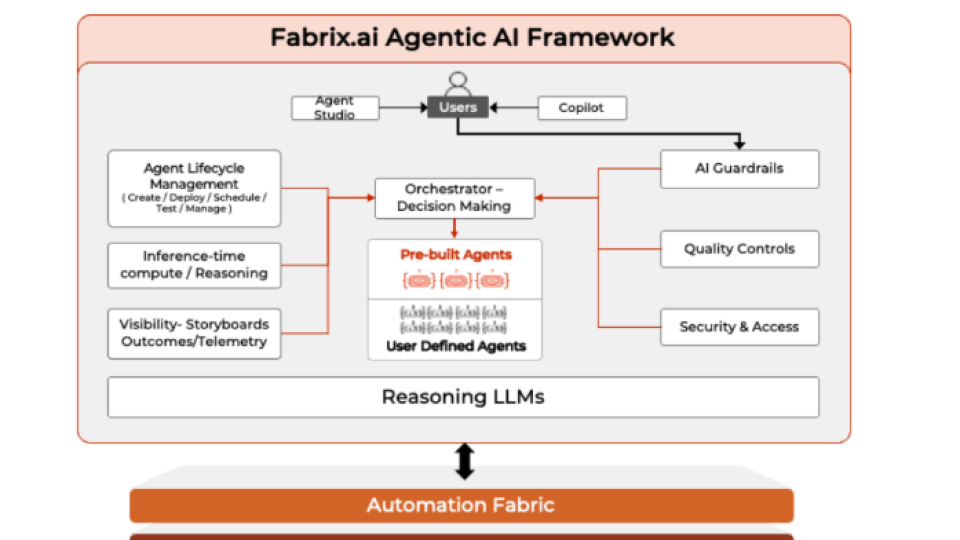
The AIOps space is a crowded one, and contains a number of leading - or sometimes bleeding - edge technology suppliers. These include the likes of BMC, Big Panda, Splunk, PagerDuty, ServiceNow, Broadcom, Datadog, IBM, and Dynatrace, among others.
Now, the AIOps (artificial intelligence for IT operations) circle has a new participant, or sort of. AIOps player CloudFabrix, known for its Robotic Data Automation Fabric Platform, has changed its name to Fabrix.ai, as it goes all out to make agentic AI central to its partner business.
Fabrix.ai represents a “natural evolution of the company's mission to provide a modern operational intelligence platform for businesses”, to “build, deploy, and manage AI agents that streamline complex tasks, accelerate digital transformation, and foster intelligent workflows”, said the company at the recently held IT Press Tour of Silicon Valley.
AI agents use foundational models for decision making, making automation contextual. They use the Sense > Reason > Plan > Act formula, and have the ability to ReAct and break down tasks and execute autonomously. They can be role-based or task-based.
Key components of an agentic AI framework:
• Agent orchestration and lifecycle management
• AI guardrails
• Managing data and action privileges for agents
• Visibility and observability of agents
• Agent quality control and assurance
• Reasoning LLMs (large language models)
Fabrix.ai's vision is to empower enterprises with AI capabilities that are not just accessible, but also “seamlessly integrated” into daily operations.
Agents are focused on accomplishing a specific outcome without the need for constant human intervention. Within the realm of IT operations and observability, these agents can sift through massive datasets and perform tasks such as supplementary data collection, issue validation, and problem correction.
Agentic workflows, powered by AI agents, achieve dynamic goals with adaptive tasks and reasoning. Curated data across the observability, networking, and security domains is crucial to prevent hallucinations, bias, and ethical issues in AI agents.
The company’s Robotic Data Automation Fabric is now extended with an AI fabric and an automation fabric to build, deploy, and manage autonomous AI agents for ITOps agentic workflows, using simple conversational phrases.
The AI fabric is an AI agent-driven distributed orchestrator that enables customers to securely build, deploy, and manage agents' lifecycles, ensuring guardrails and quality controls. It integrates with disparate large and small models, curated datasets, and automation to drive agentic workflows.
The automation fabric is an outcome-driven agentic workflow framework that integrates agents, automation, and data to build agentic workflows. It is dynamic and extensible and can also integrate with other third-party engines like Cisco BPA, NSO, Redhat Ansible, Terraform, or Camunda.
The data fabric - Robotic Data Automation Fabric (RDAF) - is a semantic-based data fabric that provides data integration with 1,000+ data bots, data ingestion, data transformation, enrichment, and data routing, using telemetry pipelines according to users’ choice of source and destination.
Examples of AI agents driving agentic workflows:
-Anomaly detection: An agent that monitors network traffic and alerts on unusual spikes or drops in activity, potentially indicating a security breach, network outage, or performance issue
-Network digital twin for service assurance: An agent that creates a digital twin of the network and creates “what-if” scenarios, predictive scenarios for service assurance, predictive maintenance, and change management scenarios for ACL (access control list) changes
-Closed loop remediation agent: An agent that automatically detects failed applications or infrastructure, performance issues or resource constraints, and provisions or scales up network capacity or cloud resources to meet increased demand, or does change management
With its offering, Fabrix.ai says businesses and partners can create their own agents with “simple” conversational prompts, thus “democratising” agentic workflows for enhanced productivity, reduced risk, and improved ROI.
"Our transition to Fabrix.ai marks an exciting new chapter in our company's journey," Raju Datla, CEO of Fabrix.ai, told the IT Press Tour. "Our rebranding is not just a change of name, but a testament to our commitment to leading the AI revolution in the ITOps space. AI agents will become the backbone of productivity, driving efficiency and intelligent decision-making across organisations."
With its pivot towards agentic AI, the company says it will expand its sales and support operations in response to expected global customer growth.
It has also put in place joint go-to-market initiatives with the likes of IBM, Cisco, Splunk, Nvidia, HPE, Evolutio, and MinIO.